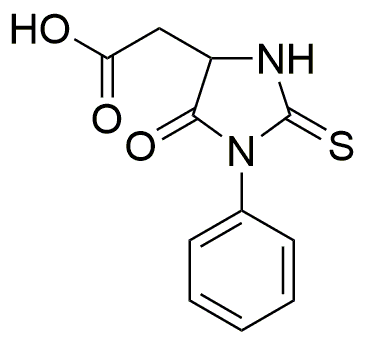Phenylthiohydantoin-aspartic acid is widely utilized in research focused on:
- Peptide Synthesis: This compound serves as a key reagent in the synthesis of peptides, helping researchers create specific sequences for studies in biochemistry and molecular biology.
- Protein Characterization: It is used in the identification and characterization of proteins, particularly in determining amino acid sequences, which is crucial for understanding protein function and interactions.
- Drug Development: The compound plays a role in pharmaceutical research, aiding in the design of new drugs by providing insights into molecular interactions and stability.
- Diagnostics: It is applied in diagnostic assays, particularly in the detection of specific proteins or biomarkers, enhancing the accuracy of medical tests.
- Research on Enzyme Activity: The compound is utilized in studies examining enzyme kinetics and mechanisms, offering valuable data for enzymology research.
General Information
Properties
Safety and Regulations
Applications
Phenylthiohydantoin-aspartic acid is widely utilized in research focused on:
- Peptide Synthesis: This compound serves as a key reagent in the synthesis of peptides, helping researchers create specific sequences for studies in biochemistry and molecular biology.
- Protein Characterization: It is used in the identification and characterization of proteins, particularly in determining amino acid sequences, which is crucial for understanding protein function and interactions.
- Drug Development: The compound plays a role in pharmaceutical research, aiding in the design of new drugs by providing insights into molecular interactions and stability.
- Diagnostics: It is applied in diagnostic assays, particularly in the detection of specific proteins or biomarkers, enhancing the accuracy of medical tests.
- Research on Enzyme Activity: The compound is utilized in studies examining enzyme kinetics and mechanisms, offering valuable data for enzymology research.
Documents
Safety Data Sheets (SDS)
The SDS provides comprehensive safety information on handling, storage, and disposal of the product.
Product Specification (PS)
The PS provides a comprehensive breakdown of the product’s properties, including chemical composition, physical state, purity, and storage requirements. It also details acceptable quality ranges and the product's intended applications.
Certificates of Analysis (COA)
Search for Certificates of Analysis (COA) by entering the products Lot Number. Lot and Batch Numbers can be found on a product’s label following the words ‘Lot’ or ‘Batch’.
Número de catálogo
Número de lote/lote
Certificates Of Origin (COO)
This COO confirms the country where the product was manufactured, and also details the materials and components used in it and whether it is derived from natural, synthetic, or other specific sources. This certificate may be required for customs, trade, and regulatory compliance.
Número de catálogo
Número de lote/lote
Safety Data Sheets (SDS)
The SDS provides comprehensive safety information on handling, storage, and disposal of the product.
DownloadProduct Specification (PS)
The PS provides a comprehensive breakdown of the product’s properties, including chemical composition, physical state, purity, and storage requirements. It also details acceptable quality ranges and the product's intended applications.
DownloadCertificates of Analysis (COA)
Search for Certificates of Analysis (COA) by entering the products Lot Number. Lot and Batch Numbers can be found on a product’s label following the words ‘Lot’ or ‘Batch’.
Número de catálogo
Número de lote/lote
Certificates Of Origin (COO)
This COO confirms the country where the product was manufactured, and also details the materials and components used in it and whether it is derived from natural, synthetic, or other specific sources. This certificate may be required for customs, trade, and regulatory compliance.


